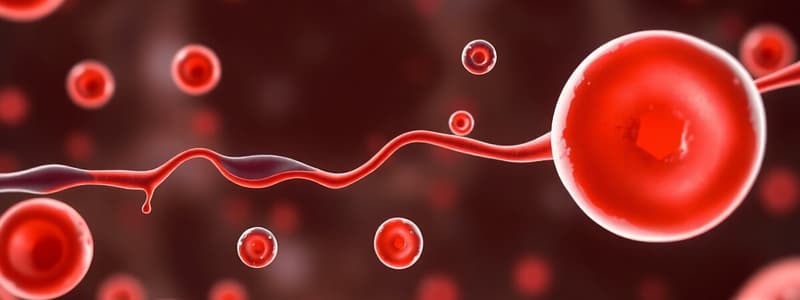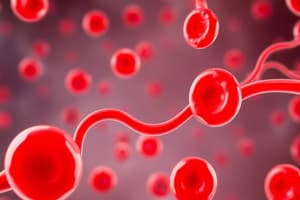Podcast
Questions and Answers
Primary hemostasis involves the activation of platelets and the blood vessels themselves.
Primary hemostasis involves the activation of platelets and the blood vessels themselves.
True (A)
The intrinsic pathway of the coagulation cascade is triggered by tissue injury.
The intrinsic pathway of the coagulation cascade is triggered by tissue injury.
False (B)
The end products of fibrinolysis are fibrin degradation products (FDPs).
The end products of fibrinolysis are fibrin degradation products (FDPs).
True (A)
Vitamin K is necessary for the activation of factors III, VII, IX, and X in the coagulation cascade.
Vitamin K is necessary for the activation of factors III, VII, IX, and X in the coagulation cascade.
Tertiary hemostasis is responsible for the stabilization and regulation of clot size.
Tertiary hemostasis is responsible for the stabilization and regulation of clot size.
Normal clotting can take as long as 10-15 minutes to initiate.
Normal clotting can take as long as 10-15 minutes to initiate.
Platelets release vasoactive compounds to induce vasoconstriction during primary hemostasis.
Platelets release vasoactive compounds to induce vasoconstriction during primary hemostasis.
Antithrombin III and Protein C are the only anticoagulants involved in the coagulation cascade.
Antithrombin III and Protein C are the only anticoagulants involved in the coagulation cascade.
Thrombosis can occur even when a blood vessel is not injured.
Thrombosis can occur even when a blood vessel is not injured.
Massive pulmonary embolism can lead to hypoxemia and shock.
Massive pulmonary embolism can lead to hypoxemia and shock.
In the Ivy method for bleeding time, the blood pressure cuff is inflated to 60 mM Hg.
In the Ivy method for bleeding time, the blood pressure cuff is inflated to 60 mM Hg.
The time taken for bleeding to stop in the Ivy method is typically between 10-15 minutes.
The time taken for bleeding to stop in the Ivy method is typically between 10-15 minutes.
An embolus is a piece of blood clot that does not travel through the bloodstream.
An embolus is a piece of blood clot that does not travel through the bloodstream.
The Duke's method involves a standardized puncture of the arm.
The Duke's method involves a standardized puncture of the arm.
Thrombosis in an artery can lead to ischemic necrosis of the supplied tissue.
Thrombosis in an artery can lead to ischemic necrosis of the supplied tissue.
The bleeding time is measured from the time the stab wound is made until bleeding begins.
The bleeding time is measured from the time the stab wound is made until bleeding begins.
Cessation of bleeding is primarily due to the formation of a clot involving fibrin.
Cessation of bleeding is primarily due to the formation of a clot involving fibrin.
The normal range for bleeding time is 1-2 minutes.
The normal range for bleeding time is 1-2 minutes.
A prolonged prothrombin time indicates a deficiency in coagulation factors I, II, V, VII, or X.
A prolonged prothrombin time indicates a deficiency in coagulation factors I, II, V, VII, or X.
Activated partial thromboplastin time (aPTT) normal range is between 20 to 30 seconds.
Activated partial thromboplastin time (aPTT) normal range is between 20 to 30 seconds.
Thrombocytopenia can lead to a prolonged bleeding time.
Thrombocytopenia can lead to a prolonged bleeding time.
Vitamin K deficiency is likely to prolong clotting time.
Vitamin K deficiency is likely to prolong clotting time.
The normal clotting time for whole blood is less than 10 minutes.
The normal clotting time for whole blood is less than 10 minutes.
A normal International Normalised Ratio (INR) is considered to be from 0.5 to 1.0.
A normal International Normalised Ratio (INR) is considered to be from 0.5 to 1.0.
Flashcards
Hemostasis
Hemostasis
The process that stops bleeding from a damaged blood vessel
Primary Hemostasis
Primary Hemostasis
The initial stage of hemostasis, involving platelets and blood vessels to form a plug
Secondary Hemostasis
Secondary Hemostasis
The stage of hemostasis where clotting factors create a fibrin clot to reinforce the platelet plug.
Platelet plug
Platelet plug
Signup and view all the flashcards
Clotting Factors
Clotting Factors
Signup and view all the flashcards
Fibrin
Fibrin
Signup and view all the flashcards
Fibrinolysis
Fibrinolysis
Signup and view all the flashcards
Extrinsic pathway
Extrinsic pathway
Signup and view all the flashcards
Thrombosis
Thrombosis
Signup and view all the flashcards
Embolism
Embolism
Signup and view all the flashcards
Blood clot
Blood clot
Signup and view all the flashcards
Pulmonary embolism
Pulmonary embolism
Signup and view all the flashcards
Bleeding time (Ivy method)
Bleeding time (Ivy method)
Signup and view all the flashcards
Bleeding time (Duke's method)
Bleeding time (Duke's method)
Signup and view all the flashcards
Ischemic necrosis
Ischemic necrosis
Signup and view all the flashcards
Embolus
Embolus
Signup and view all the flashcards
Bleeding Time
Bleeding Time
Signup and view all the flashcards
Prolonged Bleeding Time
Prolonged Bleeding Time
Signup and view all the flashcards
Coagulation Time
Coagulation Time
Signup and view all the flashcards
Prolonged Coagulation Time
Prolonged Coagulation Time
Signup and view all the flashcards
Prothrombin Time (PT)
Prothrombin Time (PT)
Signup and view all the flashcards
International Normalized Ratio (INR)
International Normalized Ratio (INR)
Signup and view all the flashcards
Activated Partial Thromboplastin Time (aPTT)
Activated Partial Thromboplastin Time (aPTT)
Signup and view all the flashcards
Haemostatic plug
Haemostatic plug
Signup and view all the flashcards



